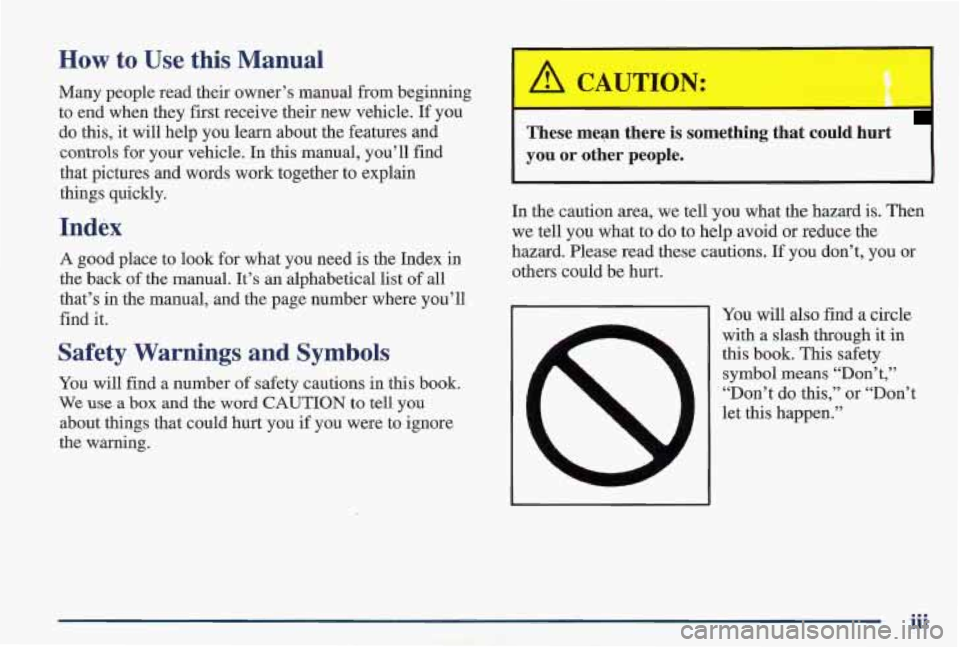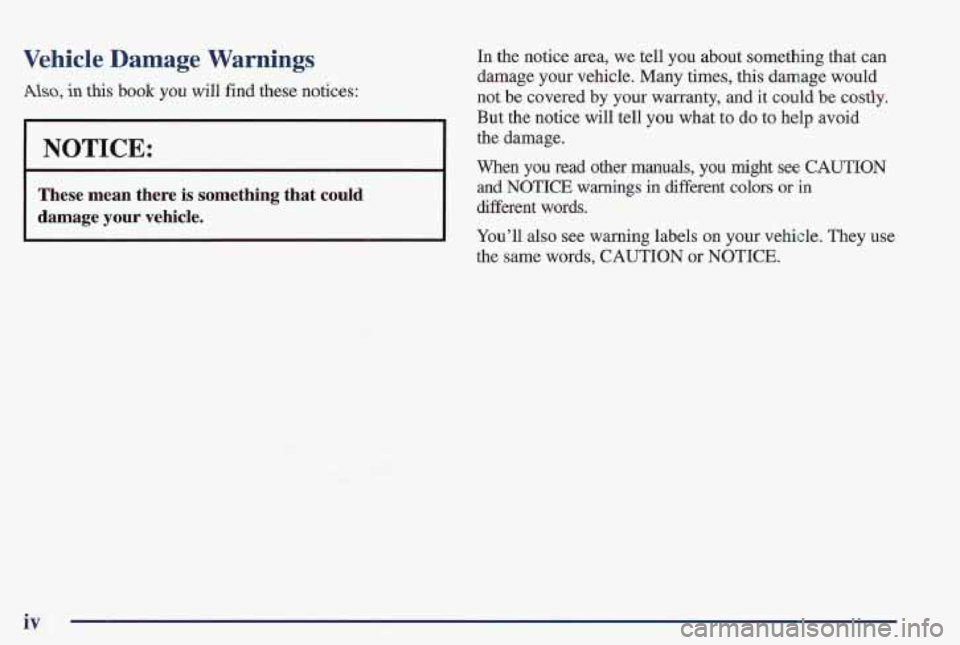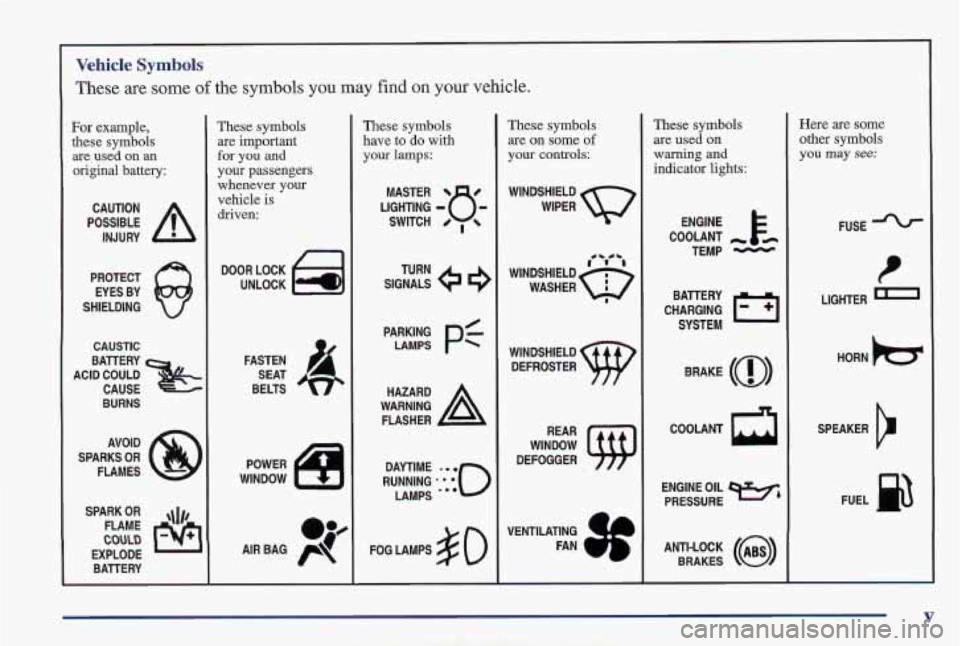warning PONTIAC FIREBIRD 1997 Owners Manual
[x] Cancel search | Manufacturer: PONTIAC, Model Year: 1997, Model line: FIREBIRD, Model: PONTIAC FIREBIRD 1997Pages: 410, PDF Size: 19.2 MB
Page 4 of 410

How to Use this Manual
Many people read their owner’s manual from beginning
to end when they first receive their new vehicle. If you
do this, it will help you learn about the features and
controls for your vehicle. In this manual, you’ll find
that pictures and words work together to explain
things quickly.
Index
A good place to look for wh,at you need is the Index in
the back of the manual. It’s
an alphabetical list of all
that’s in the manual, and the page number where you’ll
find it.
Safety Warnings and Symbols
You will find a number of safety cautions in this book.
We use a box and the word CAUTION to tell you
about things that could hurt you if you were to ignor;e
the warning.
I A CAUTION: I
These mean there is something that could hurt
you or other people.
In the caution area, we tell you what the hazard is. Then
we tell you what to do to help avoid or reduce the
hazard. Please read these cautions. If you don’t, you or
others could be hurt.
You
will also find a circle
with a slash through it in
this book. This safety
symbol means “Don’t,’’
“Don’t
do this,” or “Don’t
let this happen.”
iii
Page 5 of 410

Vehicle Damage Warnings In the notice area, we tell YOU about something that lean
damage your vehicle. Many times, this damage would
But the notice will tell you what t’o do to help avoid
the damage.
When you read other manuals, you might see CAUTION
and NOTICE warnings in different colors or in
different words.
You’ll also see warning labels on your vehicle. They use
the same words, CAUTION or NOTICE.
Also, in this book you will find these notices: not be covered by your warranty, and it could be costly.
These mean there is something that could
damage your vehicle.
iv
Page 6 of 410

Vehicle Symbols
These are some of the symbols you may find on your vehicle.
For example,
these symbols
are used on an
original battery:
POSSIBLE A
CAUTION
INJURY
PROTECT EYES BY
SHIELDING
CAUSTIC
ACID COULD BATTERY
CAUSE
BURNS
AVOID
SPARKS
OR
FLAMES
FLAME
EXPLODE BATTERY
These symbols are important
for you and
your passengers
whenever your
vehicle
is
driven:
DOOR LOCK
UNLOCK
FASTEN SEAT
BELTS
.i)
AIR BAG p
These symbols
have to do with
your lamps:
SIGNALS 6
TURN
PARKING
PC LAMPS
FOG LAMPS
$0
These symbols
are on some
of
your controls:
WINDSHIELD
DEFROSTER
WINDOW
DEFOGGER
VENTILATING FAN
These symbols are used on
warning and
indicator lights:
COOLANT -
TEMP -
CHARGING BATTERY
SYSTEM
BRAKE
(0)
COOLANT a
ENGINE OIL w,
PRESSURE
ANTI-LOCK
(@)
BRAKES
Here are some
other symbols
you
may see:
FUSE
LIGHTER
1
HORN )cT
SPEAKER
b
FUEL p3
Page 50 of 410

Section 2 Features and Controls
~~ ~ ~
Here you can learn about the many standard and optional features on your Pontiac, and information on starting,
shifting and braking. Also explained are the instrument panel and the warning systems that tell you if everything is
working properly -- and what to do if you have a problem.
2-2
2-4
2-6
2-
10
2-12
2-13
2-1 6
2- 17
2-23
2-23
2-25
2-27 2-28
2-32
2-37
2-3 8
2-40
Keys
Door Locks
Remote Keyless Entry System
Hatch
Theft
Vehicle and Content Theft-Deterrent System
Feature Customization New Vehicle “Break-In”
Ignition Switch
Starting Your Engine
Engine Coolant Heater
Automatic Transmission Operation
Manual Transmission
Parking Brake
Shifting Into PARK (P)
Parking Your Vehicle
PASS-K@ 11
2-40
2-4 1
2-4
1
2-43
2-43
2-44
2-44
2-5 1
2-54
2-56
2-5
8
2-59
2-60
2-6 1
2-68
2-74
2-77
Shifting Out of PARK (P)
Parking Over Things That Burn
Engine Exhaust
Windows
Horn
Tilt Steering Wheel
Turn SignaVMultifunction Lever
Lamps
Interior Lamps
Mirrors
Storage Compartments
Ashtray and Lighter
Sun Visors
Floor Mats
Convertible
Top
Instrument Panel
Warning Lights,
Cages and Indicators
2-1
Page 73 of 410

If you have an automatic transmission, the ignition
switch can’t be turned to
LOCK unless the shift lever is
in the PARK (P) position.
OFF (C): Unlocks the steering wheel, ignition and
automatic transmission, but does not send electrical
power to any accessories. Use this position if your
vehicle
must be pushed or towed. A warning tone will
sound if you open the driver’s door when the ignition is
in OFF and the key is in the ignition.
RUN (D): Position to which the switch returns after you
start your engine and release the switch. The switch
stays in the
RUN position when the engine is running,
But even when the engine is not running, you can
use RUN to operate your electrical power accessories
and to display some instrument panel warning and
indicator lights.
START (E): Starts the engine. When the engine starts,
release the key. The ignition switch will return to RUN
€or normal driving.
Note that even if the engine is not running, ACC and
RUN allow you to operate your electrical accessories,
such
as the radio and ventilation fan.
Key Release Button
If you have a manual
transmission, your ignition
lock has a key release
button.
You must press the
button before you can take
your key out
of the
ignition
lock.
On manual transmission vehicles, turn g the key
to
LOCK will lock the steering column and result
in a loss
of ability to steer the vehicle. This could
cause
a collision. If you need to turn the engine
off while the vehicle is moving, turn the key only
to OFF. Don’t press the key release button while
the vehicle
is moving.
2-24
Page 86 of 410

Parking Brake
To set the parking brake, hold the brake pedal down and
pull up on the parking brake lever.
If the ignition is on,
the brake system
warning light will come on.
To release the parking brake, hold the brake pedal down.
Pull the parking brake lever up until you can push in the
release button. Hold the release button in as you move
the brake lever all the way down.
2-37
Page 126 of 410

Speedometer and Odometer
Your speedometer lets you see your speed in both miles
per hour (mph) and kilometers per hour (kmk). Your
odometer shows how far your vehicle has been driven,
in either miles (used in the United States)
or kilometers
(used in Canada).
You may wonder what happens if your Pontiac needs a
new odometer installed.
If possible, the new one has to be
set
to the same reading the old one had. If it can’t be, then
it’s set at zero, but a label on
the driver’s door must show
the old reading and when the new one was installed.
Trip Odometer
The trip odometer can tell you how far your vehicle has
been driven since you last set the trip odometer
to zero.
To set the trip odometer to zero, press the knob.
Tachometer
The tachometer displays the engine speed in thousands
of revolutions per minute (rpm).
NOTICE:
Do not operate the engine with the tachometer in
the red area, or engine damage may occur.
Warning Lights, Gages and Indicators
This part describes the warning lights and gages that may
be
on your vehicle. The pictures will help you locate them.
Warning lights and gages can signal that something is
wrong before it becomes serious enough to cause
an
expensive repair or replacement. Paying attention to
your warning lights and gages could also save you
or
others from injury.
Warning lights come on when there may be or
is a
problem with one
of your vehicle’s functions. As you will
see in the details on the next few pages, some warning
lights come on briefly when you
start the engine just to let
you
know they’re working. If you are familiar with this
section, you should not be alarmed when this happens.
Gages can indicate when there may be or is a problem
with one
of your vehicle’s functions. Often gages and
warning lights work together to let you know when
there’s a problem with your vehicle.
When one
of the warning lights comes on and stays on
when you are driving, or when one
of the gages shows
there may be a problem, check the section that tells you
what to do about it. Please follow this manual’s
advice.
Waiting to do repairs can be costly -- and even
dangerous.
So please get to know your warning lights
and gages. They’re a big help.
2-77
Page 128 of 410

Voltmeter
You can read battery
voltage on your voltmeter.
If it reads less than 11 volts
or more than
16 volts while
your engine is running, and
it stays there, you may have
a problem with the
electrical charging system.
Brake System Warning Light
Your Pontiac’s hydraulic brake system is divided into
two parts.
If one part isn’t working, the other part can
still work and stop you.
For good braking, though, you
need both parts working well.
If the warning light comes on, there could be a brake
problem or the brake fluid level could
be low. Have your
brake system inspected right away.
Have it checked right away. Driving with the voltmeter
reading in a warning zone could drain your battery.
If you idle your engine for a while, the voltmeter
reading might move into the yellow zone.
If the reading
stays in the yellow zone while you are driving, you may
have a problem with the electrical charging system.
Have
it checked. While the voltmeter reads in the yellow
zone, your battery may not be able to power certain
electrical accessories, like
ABS. (If this happens, your
ABS INOP light will come on. See “Anti-Lock Brake
System Warning Light” in this part.)
If you must drive a short distance with
the voltmeter
reading in
a warning zone, turn off all your accessories,
including your air conditioning and audio system.
BRAKE
This light should come on
briefly when you turn
the ignition key to
RUN. If
it doesn’t come on then,
have it fixed
so it will be
ready to warn you if there’s
a problem.
If the light comes on while you are driving, pull off the
road and stop carefully.
You may notice that the pedal is
harder to push. Or, the pedal may
go closer to the floor.
It may take longer to stop. If the light is still on, or if the
anti-lock brake system warning light is flashing, have
the vehicle towed for service. (See “Anti-Lock Brake
Page 129 of 410

System Warning Light” and “Towing Your Vehicle” in Anti-Lock 1- System Warning Eight
the Index.)
Your braKe s cem may not be working properly
if the brake system warning light is on. Driving
~ with the brake system warning light on can lead
to an accident.
If the light is still on or if the
anti-lock brake system warning light
is flashing
after
you’ve pulle’d of€ the road and stopped
~
!
ABS
INOP
With the anti-lock brake
system, this light will come
on when you start your
engine and it will stay
on for three seconds.
That’s normal.
carefully, have the vehicle towed for service. If the light flashes when you’re driving, you don’t have
anti-lock brakes and there could be
a problem with your
regular brakes. Pull off the road and stop carefully. You
When the ignition is on* the brake system warning light may notice that the pedal is harder to push. or, the pedal
on when YOu set Your Parking brake* The may go closer to the floor, It may take longer to stop,
light will stay
on if your parking brake doesn’t release Have the vehicle towed for service. (See “Towing Your
fully.
If it stays on after your parking brake is fully Vehicle” in the Index.)
released, it means you have
a brake problem.
2-80
Page 130 of 410

Traction Control System Warning Light
(If Equipped)
I
Your regular brake system may not be working
properly if the anti-lock brake system warning
light is flashing. Driving with the anti-lock
brake system warning light flashing can lead to
an accident. After you’ve pulled off the road
and stopped carefully, have the vehicle towed
for service.
If the anti-lock brake system warning light stays on
longer than normal after you’ve started your engine, turn
the ignition off. Or, if the light comes on and stays on
when you’re driving, stop as soon as possible and turn
the ignition off. Then start the engine again to reset the
system.
If the light still stays on, or comes on again
while you’re driving, your Pontiac needs service. If the
light is on but not flashing and the regular brake system
warning light isn’t on, you still have brakes, but you
don’t have
anti-lock brakes.
The anti-lock brake system warning light should come
on briefly when you turn the ignition key to RUN. If the
light doesn’t come on then, have it fixed so it will be
ready to warn you if there is a problem.
TCS
OFF
This warning light should
come on briefly as you start
the engine.
If the. warning
light doesn’t come on then,
have it fixed
so it will be
ready to warn you if there’s
a problem.
If it stays on, or comes on when you’re driving, there
may be a problem with your traction control system and
your vehicle may need service. When this warning light
is on, the system will not limit wheel spin. Adjust your
driving accordingly.
If your brakes begin to overheat, the brake portion of the
traction control system will shut down, but the throttle
and engine spark control will continue
to work. The
warning light will not come on when this happens.